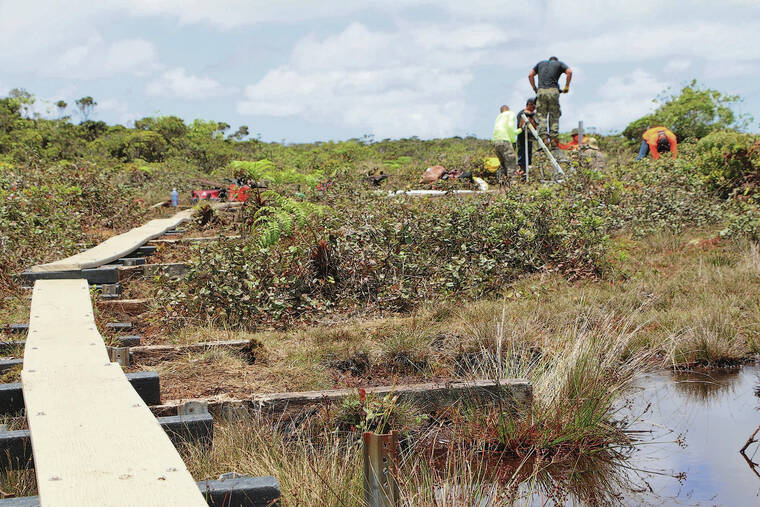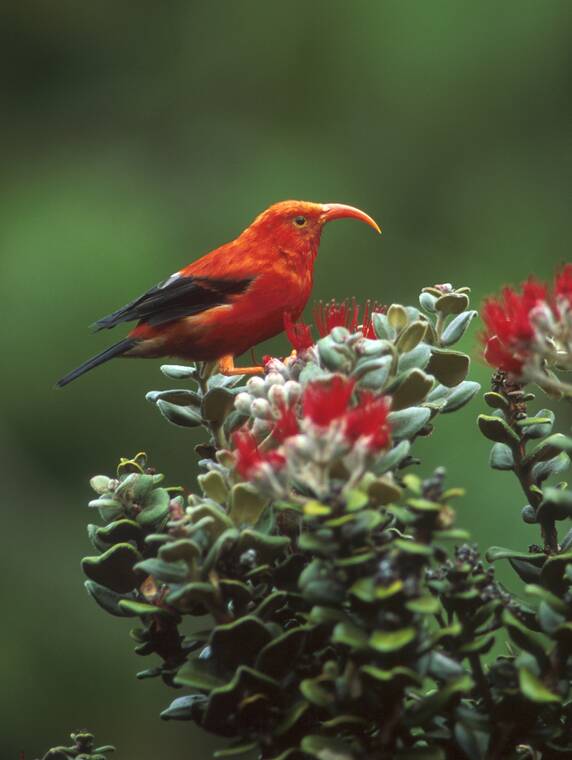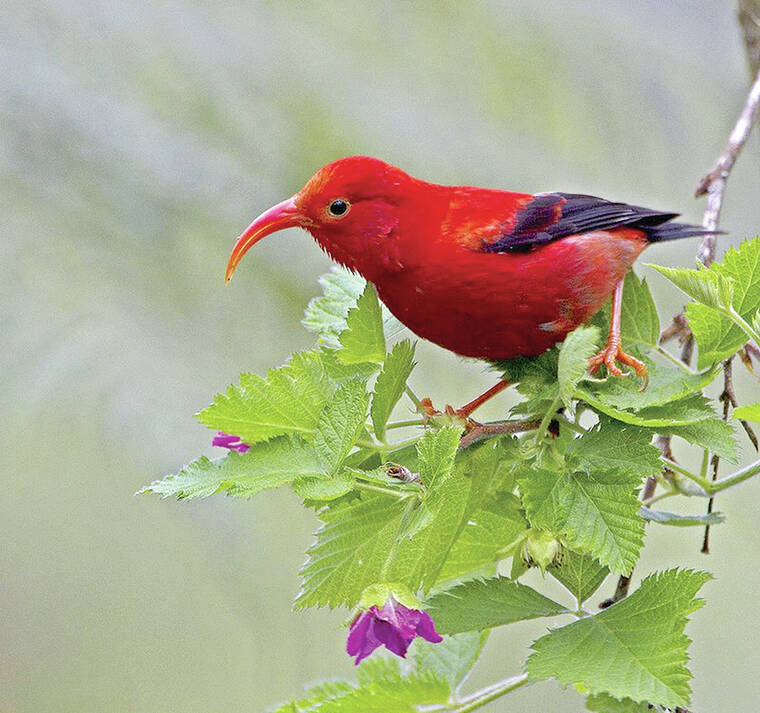LIHU‘E — The U.S. Fish and Wildlife Service proposed Tuesday to designate more than 275,000 acres of Hawaiian land — including 12,510 acres in Kaua‘i’s Alaka‘i Plateau — as protected critical habitat for the ‘i‘iwi, one of Hawai‘i’s most iconic and endangered honeycreepers.
Known for their bright red plumage, black wings and long, curved bill, the ‘i‘iwi were first listed as threatened by the Fish and Wildlife Service in 2017. Once abundantly found from sea level to tree lines across the Hawaiian Islands, only an estimated 600,000 ‘i‘iwi remain in higher elevations on Kaua‘i, Maui and Hawai‘i Island.
Designating land as critical habitat for ‘i‘iwi simultaneously helps to focus conservation efforts and requires federal entities to contact the Fish and Wildlife Service before conducting activities within or adjacent to the land.
“Species without designated critical habitat are half as likely to move toward recovery as species with critical habitat,” said Maxx Phillips, staff attorney and director of the Center for Biological Diversity’s Hawai‘i program. “So, these protections are extremely important to ensure that the ‘i‘iwi will not continue to lose what little disease-free habitat still remains.”
Invasive mosquitoes carrying avian malaria pose the greatest threat to Hawaiian forest bird species, according to the U.S. Department of the Interior. Even among these birds, the ‘i‘iwi is particularly vulnerable to the disease — with a 95 percent mortality rate, one mosquito bite can prove fatal.
“Our researchers think that the birds are not able to adapt,” said Lasha-Lynn Salbosa, classification and listing program manager for the Pacific Islands at the Fish and Wildlife Service. “They’re just not able to withstand the onslaught of attacks from avian disease.”
Because the mosquitoes can’t live in cooler environments, the ‘i‘iwi and other forest birds have taken shelter in higher elevations. But as climate change increases temperatures along the mountainsides, disease-free lands suitable for forest bird habitation grow thinner.
This spells particular danger for Kaua‘i’s ‘i‘iwi population. Lacking multiple habitable locations, the island’s population is limited to the Alaka‘i Plateau. With an estimated population of only 1,000 remaining on Kaua‘i, and with mosquitoes creeping toward what little habitat is left, ‘i‘iwi on the Garden Island are likely to disappear within 30 years, according to the Center for Biological Diversity.
“So, (on Maui and Hawai‘i Island) you have multiple high-elevation areas that can be a sanctuary — a safe haven away from avian disease,” Phillips said. “We don’t have that on Kaua‘i.”
As mosquitoes continue to jeopardize ‘i‘iwi populations, ongoing threats to ‘ohi‘a trees further imperil the forest bird.
“I cannot stress this more — ‘ohi‘a is the keystone species of Hawai‘i,” Salbosa said. “It just is. It’s the first plant to break forth from a lava field, it colonizes the lava field. It provides food for our birds. It provides shelter for our ferns. It just is.”
I‘iwi primarily feed on nectar from ‘ohi‘a lehua blossoms, and are only found to nest in ‘ohi‘a trees. Conversely, pollination by birds like the ‘i‘iwi have been found to assist the ‘ohi‘a’s seedset, helping the trees to propagate.
But as competing invasive plants, feral ungulates such as boars and deer, and a number of diseases including ceratocystic fimbriata (commonly known as rapid ‘ohi‘a death) cull the ‘ohi‘a’s numbers across Hawai‘i, a crucial part of the ‘i‘iwi’s ecosystem continues to disappear.
Salbosa notes this interconnectivity doesn’t stop at birds and trees, though — a threat to Hawaiian wildlife is a threat to Hawaiian culture.
“Once these species are gone, part of Hawai‘i is gone,” she said. “And I think that’s something that keeps me doing what I do. It’s really the connection to Native Hawaiian mo‘olelo (stories) and songs and oli and hula that tries to encapsulate and show this connection. And it becomes, for example, part of a hula dancer, when they’re emulating this connection that the ‘i‘iwi has to a particular ‘ohi‘a tree. It’s perpetuating that story — it’s passing that on — so that it remains alive.”
Salbosa urges the public to take care not to damage Hawai‘i’s trees, noting that trampling, climbing on and notching ‘ohi‘a significantly increase the risk of tree death.
“Everybody wants to get outside,” she said. “And I, for one, encourage my staff and my friends — people from here and not from here — to hike into our forests. But there are ways to do it with reverence. There are ways to do it safely, and there are ways to do it consciously. And that’s what we need to do, because our population in Hawai‘i is just going to increase, and we need to be aware of these connections that make Hawai‘i, Hawai‘i.”
•••
Jackson Healy, reporter, can be reached at 808-245-0427 or jhealy@thegardenisland.com.




